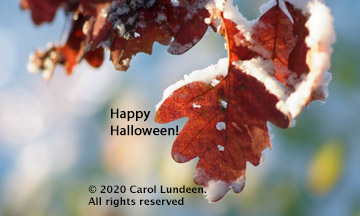
Happy Halloween from your friendly neighborhood white oak tree, and one of its friendly ghost-like leaves!

 Here’s an example of using contrast as a visual principle of landscape design. In the foreground of this scene in Cambridge, MA, leaves of a variegated dogwood tree contrast along a diagonal with the pink flowers of a blooming azalea shrub in the middle ground, while in the background the curly-edged rumpled leaves of perennial geraniums anchor as a groundcover.
Here’s an example of using contrast as a visual principle of landscape design. In the foreground of this scene in Cambridge, MA, leaves of a variegated dogwood tree contrast along a diagonal with the pink flowers of a blooming azalea shrub in the middle ground, while in the background the curly-edged rumpled leaves of perennial geraniums anchor as a groundcover.
In addition to contrast, other principles of landscape design include unity and harmony, balance, hierarchy, scale and proportion, dominance and emphasis, and similarity and contrast. Design elements such as color, line, shape and volume, texture and pattern, space the illusion of space, motion and the illusion of motion and value can be combined as ingredients in a recipe that creates the various design principles that make a design a visual success.Other elements of a successful landscape design are functional, such as circulation around a home and its grounds, and water management.
Garden-911 Boston offers landscape design services. Visit https://www.garden-911.com/ or call 617-327-9254 for more information.

LOOKING FOR A LARGE, STRAIGHT-TRUNKED FLOWERING NATIVE TREE FOR YOUR LANDSCAPE? Consider a tulip tree for your design, Liriodendron tulipifera. It grows up to 200 feet in height, and features yellow and orange tulip-shaped flowers and leaves. I came across this one at Stodderd’s Neck State Park in Hingham, MA, an off-leash dog park overlooking Weymouth Back River.

A note from a friendly frittilary butterfly: stepping in your garden or working on your lawn when the soil is wet damages your plants’ ability to thrive. (Image 2017 Carol Lundeen. ALL RIGHTS RESERVED)
#1. CAUTION: WET SOIL – DO NOT ENTER YOUR GARDEN – OR WORK ON YOUR LAWN!
#2. GET YOUR SOIL TESTED – BEFORE YOU PLANT!
#3. START YOUR COOL-SEASON VEGETABLES – ONCE THE SOIL DRAINS!
#4. EAGER TO JUMP START YOUR LAWN?
#5. MONITOR FOR WINTER MOTH CATERPILLARS
(BONUS #6.) CELEBRATE ARBOR DAY BY PLANTING A TREE ON APRIL 28
AS ALWAYS,PLEASE FEEL FREE TO CONTACT ME IF YOU HAVE ANY QUESTIONS OR NEED A HAND!
EMAIL CAROL OR CALL 617-327-9254